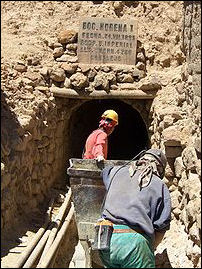Main Listing Page
Silver Mines Of Potosi Bolivia
In the country of Bolivia in the city of Potosi is located what was once one of the most biggest silver mines ever found : The Cerro Rico ("rich mountain")—a mountain popularly conceived of as being "made of" silver ore, which has always dominated the city. The Cerro Rico is the reason for Potosí's historical importance, since it was the major supply of silver for Spain during the period of the New world Spanish Empire This silver was taken by llama and mule to Spain on the Spanish treasure fleets.
Cerro de Potosí's peak is 4,824 meters (15,827 ft) above sea level.
It is from Potosí that most of the silver shipped through the Spanish Main came. According to official records, 45,000 short tons (41,000 metric tons) of pure silver were mined from Cerro Rico from 1556 to 1783. Of this total, 9,000 short tons (8,200 metric tons) went to the Spanish monarchy. Due to such extensive mining, the mountain itself has diminished in height; before the mining started it was a few hundred meters higher than it is today. Indian laborers, forced by Francisco de Toledo, Count of Oropesa through the traditional Incan mita institution of contributed labor, came to die by the millions, not simply from exposure and brutal labor, but by mercury poisoning: in the patio process the silver-ore, having been crushed to powder by hydraulic machinery, was cold-mixed with mercury and trodden to an amalgamation by the native workers with their bare feet. The mercury was then driven off by heating, producing deadly vapors.
Silver production reached its peak around the year 1650, at which the veins began to run out, and Potosi became a downhill path which never failed to recover.
After 1800, the silver mines were depleted, making tin the main product. This eventually led to a slow economic decline. Nevertheless, the mountain continues to be mined for silver to this day. Due to poor worker conditions (lack of protective equipment from the constant inhalation of dust), the miners still have a short life expectancy with most of them contracting silicosis and dying around 40 years of age. It is estimated that hundreds of thousands of Indians died under the harsh working conditions.
The city which essentially supported the splendor of Spain from the sixteenth to the eighteenth centuries while its own native peoples suffered the hardships of slavery, today is a city of poverty. There are a few mines in operation, with mining methods changed little over the centuries.
The historic center of the city, once occupied by Spanish settlers, is home to a small middle class. This area is surrounded by a poverty belt whose residents are miners who work in the co-operatives. This area is surrounded by an even wider belt of poverty, home to those who have fled the countryside and come to Potosi to hire themselves out as unskilled laborers in the mines.
Mining activity in Potosi slowed down only after the country's independence in 1825. The remains of this mining era includes numerous dams that controlled the ore-grinding mills and the Royal Mine Complex. Monuments of the once colonial city, 22 parish or monastic churches, patrician homes and the Royal Mint also remain, along with the contrasting humble 'rancherias' of the native quarters.
The city of San Luis Potosi in Mexico was named after Potosí in Bolivia. In the United States, the name Potosi was optimistically given to lead-mining towns of Potosi, Wisconsin and Potosi, Missouri, and also to the silver-mining town of Potosi, Nevada.






